Secrets of winter garlic care in spring
Garlic is a culture that humanity has known for thousands of years. The benefits of garlic for the human body is an indisputable fact. Studies have shown that regular consumption of vegetables increases immunity, reduces the frequency and intensity of viral and colds.
Besides, garlic is a storehouse of vitamins and essential minerals. It reduces blood pressure, prolongs youth, and has an antibacterial effect. You can talk endlessly about the beneficial properties of this bulbous plant, but it's better to plant him at his site and make sure in practice. How to do it correctly and get a rich harvest of winter garlic, we will tell in the article.
The content of the article
Differences between winter and spring garlic
Garlic is a bulbous plant. There are two types of garlic: spring and winter. They differ externally and by the method of landing.
Spring garlic is planted at the beginning of the season, when the ground warms up a little (up to 5-7 degrees), but still retains moisture. The culture does not like completely damp soil - the roots begin to rot, and then the bulb itself.
The winter crop is planted in late autumn, about two to three weeks before frost, so that the garlic has time to take root.
Using the table, you can easily see the differences between species.
| Winter garlic | Spring garlic |
| Frost resistant. | Does not withstand low temperatures. |
| A large onion with 6 to 10 large cloves. | The bulb is smaller, the teeth are also small, up to 30 pieces. |
| The teeth are even, growing in a circle. | The teeth are arranged chaotically. |
| The arrow to delete. After removal, it remains in the form of a solid stem in the center of the bulb, cloves grow around it. | It has no arrow. |
| The shelf life is short, therefore it is recommended to use it within several months after collection. | Stored until the next harvest. |
| Ripens long before the end of the garden season. | It does not always have time to ripen in a zone with a cold climate. |
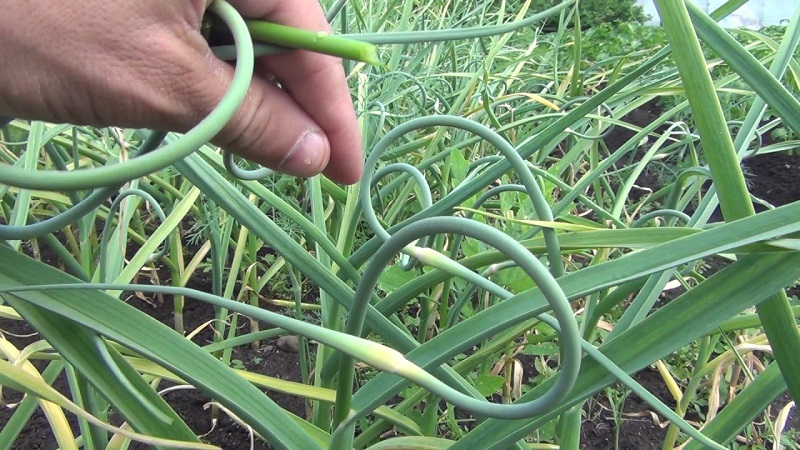
How to care for winter garlic in spring
Winter crops are not afraid of cold weather, because garlic germinates early. If you wrapped the beds from frost for the winter, as soon as the snow melts, you need to remove the protective shelter. Winter garlic care includes loosening, watering and feeding. Timely weeding is also important.
Loosening the soil in the aisles of garlic
How to care for garlic in spring? When the snow melted and the first shoots appeared, the most important task of gardeners is to keep moisture in the ground, to provide oxygen access to the root system of garlic. This requires thorough loosening between the rows and the plants themselves.
In caring for winter garlic, a lot depends on the weather conditions. When the ground in the beds starts to turn gray instead of black, it's time to loosen. Further loosening is carried out after each heavy rain. If there is no rain, then after watering.
Attention! If you are late with loosening, on the surface soil a thin crust forms. Over time, it hardens, cracks form, moisture evaporates faster at times. It is already difficult to remove such a peel, deep loosening will be required, which can damage the young roots of garlic.
How to properly water with water and saline
Garlic tolerates drought quite well, but the harvest is unlikely to be plentiful.Therefore, you need to provide the culture with good watering. Moisture is especially important in spring. For proper formation and growth of heads, the soil must be sufficiently moistened.
Watering
The irrigation scheme for both types (spring and winter) is identical and looks like this:
| Climatic conditions | Watering |
| Rainy or cloudy weather | – |
| Hot dry weather | Every 5 days |
| Moderately hot, rainy weather | Every 7-10 days |
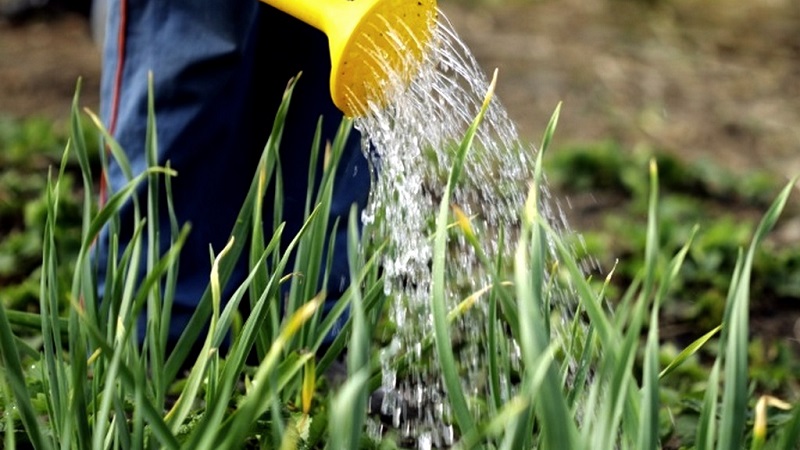
Why water with saline
Garlic, like other garden crops, suffers from pests... Watering with saline will help get rid of them. In addition, this solution promotes better nitrogen absorption, which is important for the culture.
The first watering with saline is carried out in late May or early June. Watering is done every ten days. The watering scheme is as follows:
- 100g salt / bucket of water;
- 300g salt / bucket of water;
- 400g salt / bucket of water;
- 600g salt / bucket of water.
The fourth time can be watered only as a last resort, when the site is highly infested with pests. A bucket of mortar should be enough for 2 square meters. m.
Be careful! Saline solution is a good helper, but it should be used in moderation, as it “greases” in large quantities and depletes the earth. For more than three years in a row, such a procedure cannot be carried out in one place. It is necessary to change cultures in places. And if the soil is still saline, plant a white clover - it will restore the salt balance.
Treatment of shoots with saline
For volatile pests, such as onion flies, saline is also used. The proportion is as follows: 250 g of salt / bucket of warm water (10 L). The solution is sprayed onto the aerial part of the plant with a spray bottle. It is best to leave the solution overnight, and in the morning spray the shoots with plain water and water the beds. For prevention purposes, such a procedure is recommended to be carried out every ten days.
How to help garlic
For garlic to grow healthy and form large heads and abundant feathers, it needs a sufficient amount of nitrogen, phosphorus, potassium and other trace elements. Special feeding will help to ensure the correct balance of nutrients required for growth and development.
In order for the harvest to please you, observe exactly the proportions and timing of application, otherwise the result may be the opposite (for example, abundant development of the green part to the detriment of head formation).
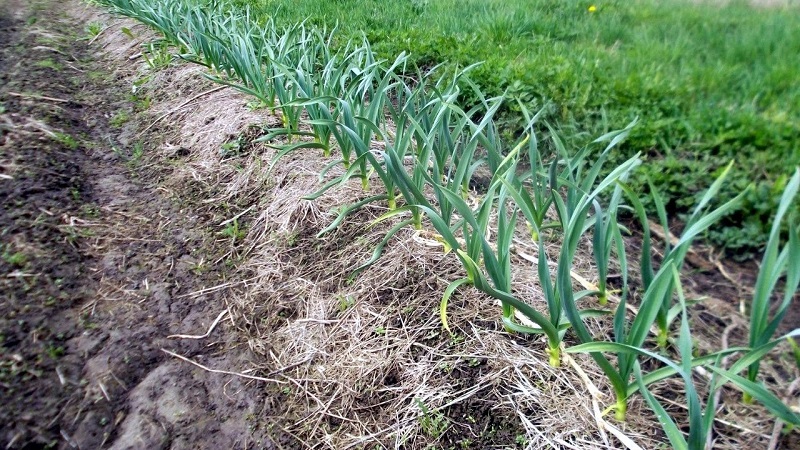
Spring feeding
The most active plant growth occurs, of course, in the spring. It is during this period that it is important to feed the garlic in time - both winter and spring. Winter garlic is fed a week after the snow melts, and then another two weeks later. Spring garlic is fed after three to four leaves have formed. The second feeding is carried out after another two weeks.
Top dressing in summer
The third feeding is carried out in the summer, in mid-June. It is important that it falls exactly at the time of head formation, otherwise all fertilizers will be wasted. And if you spend it ahead of time, the green part and arrows will form too abundantly.
Types of mineral dressings
Urea is great for spring feeding. It contains large amounts of nitrogen. It is used as follows: a tablespoon of fertilizer is dissolved in 10 liters of water. It is brought in at the rate of 3 liters of solution per sq. m area.
Ammonium nitrate is also a nitrogenous fertilizer. 15 mg of the substance is diluted in 10 liters of water. The consumption is the same as in the previous case. It is recommended to feed in the spring with an interval of three weeks.
Nitroammofoska is a fertilizer containing potassium, phosphorus, nitrogen, sulfur. For foliar feeding, one tablespoon is diluted in 10 liters of water. fertilizers. For root feeding, the dose for the same container is doubled.
Superphosphate contains phosphorus - it improves the quality of the bulb, it grows larger, more juicy, and has a longer shelf life. Prepare the solution as follows: 2 tbsp. fertilizers per 10 liters of water. This composition is enough to process 2 sq. m.
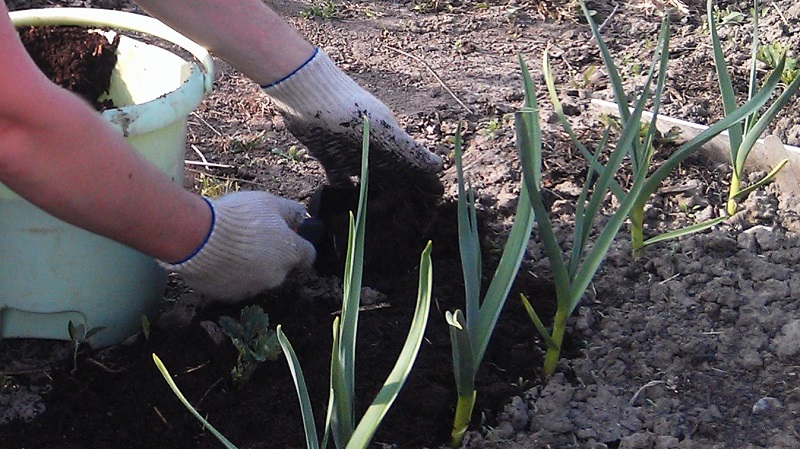
Varieties of organic fertilizers
Ash will enrich plants with potassium and phosphorus.You can just sprinkle it on the beds, or you can prepare an infusion - for 10 liters of water a jar of 0.5 liters of ash. The solution is infused for a day and applied at the root.
Yeast contains important amino acids. Dilute 200 g of raw yeast per liter of water. The solution is infused for a day, and then it is brought to 10 liters. Then pour garlic on it.
Ammonia is a source of nitrogen. The proportions of the solution: for 10 l of water 25 ml of ammonia. Feathers are treated with the composition. You can prepare a solution for watering the land, but it must be applied before planting the plants.
When to harvest and how to store winter garlic
It is believed that a hundred days is enough for winter garlic to ripen. It is usually harvested in late July and early August. And spring - at the end of August-September. It is not difficult to determine the degree of ripening, it is enough to know some simple rules:
- the lower leaves of the stem (or all the leaves and stem) have turned yellow and dry;
- in winter garlic, to determine maturity, arrows are often left on several bulbs: when they are straightened, and the inflorescences have opened, the garlic is ripe;
- dig up a few onions. The husks on them should be completely dry, lilac-white in color. Garlic is well stored, which has three layers of husk;
- the lobules should be well formed, elastic and easily separate from each other, but not crumble;
- in non-shooting garlic, the root collar usually turns out to be dry, it is easily separated from the cloves.
Storing winter garlic
An important condition for long-term storage of garlic is timely and correct harvesting. The bulbs should not be dug up much earlier or later. Garlic must not be overripe. It is better to dig it up a couple of days earlier and allow it to ripen when it dries, as overripe garlic in the ground quickly begins to rot.
Remove the garlic carefully, taking care not to damage the cloves. It is necessary not to pull out, but to dig out - for example, with a shovel. The earth is removed from the bulbs by hand. Do not hammer it against a shovel or knock the bulbs against each other - this will damage them and are no longer suitable for long-term storage.
After the garlic heads are dried outside in the shade or in a well-ventilated room, along with the tops, onions down. This will improve the taste of garlic, because all the nutrients will penetrate from the foliage and stem into the head. For storage, whole undamaged bulbs are taken, completely covered with husks.
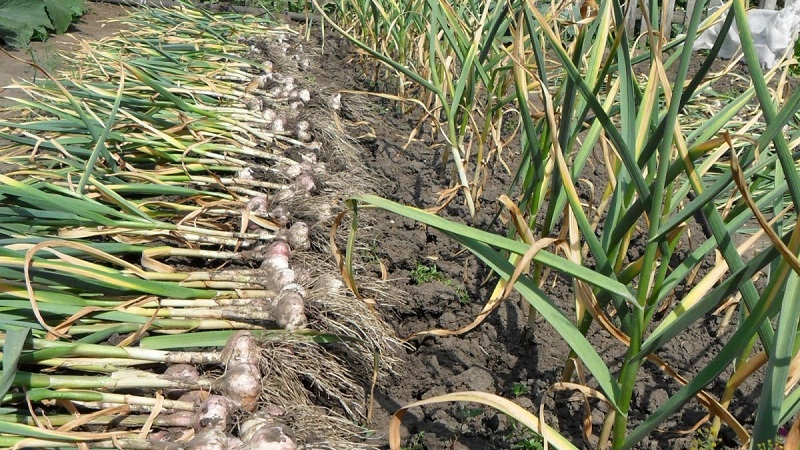
Optimal storage conditions for garlic
Bulbs should be stored in a dark place at temperatures ranging from -2 to +2 degrees and humidity below 80%. It is advisable to rid the fruit of excess air intake.
Garlic can be stored in a cellar or basement, suspended in braids. Store it in cardboard or plywood boxes. You can store garlic in apartments. To do this, lay it in layers in jars as a whole or disassembled into slices, without removing the husk. First, they prepare the container, wash and dry it thoroughly. As a material for pouring, you can use salt, flour, onion peels, expanded vermiculite, ash.
The still peeled cloves are stored in oil. They also dip garlic cloves in paraffin - this way it is stored longer. Another way is storage in sterile jars with a tightly closed lid in a cool place. Or in a cloth bag pre-soaked with saline and dried. The longest storage method is freezing or drying for seasoning.
Conclusion
Garlic is a bulbous plant, valuable for both its taste and medicinal properties, vitamin and mineral composition. It is not difficult to grow and maintain it. The culture is grown both on its own plot for personal use and on an industrial scale.
For successful cultivation, it is enough to follow simple agrotechnical rules. It is important to pay special attention to caring for your garlic after winter. Then provide sufficient watering, timely feeding, loosen and remove weeds as needed - and the garlic will delight you with a wonderful harvest.